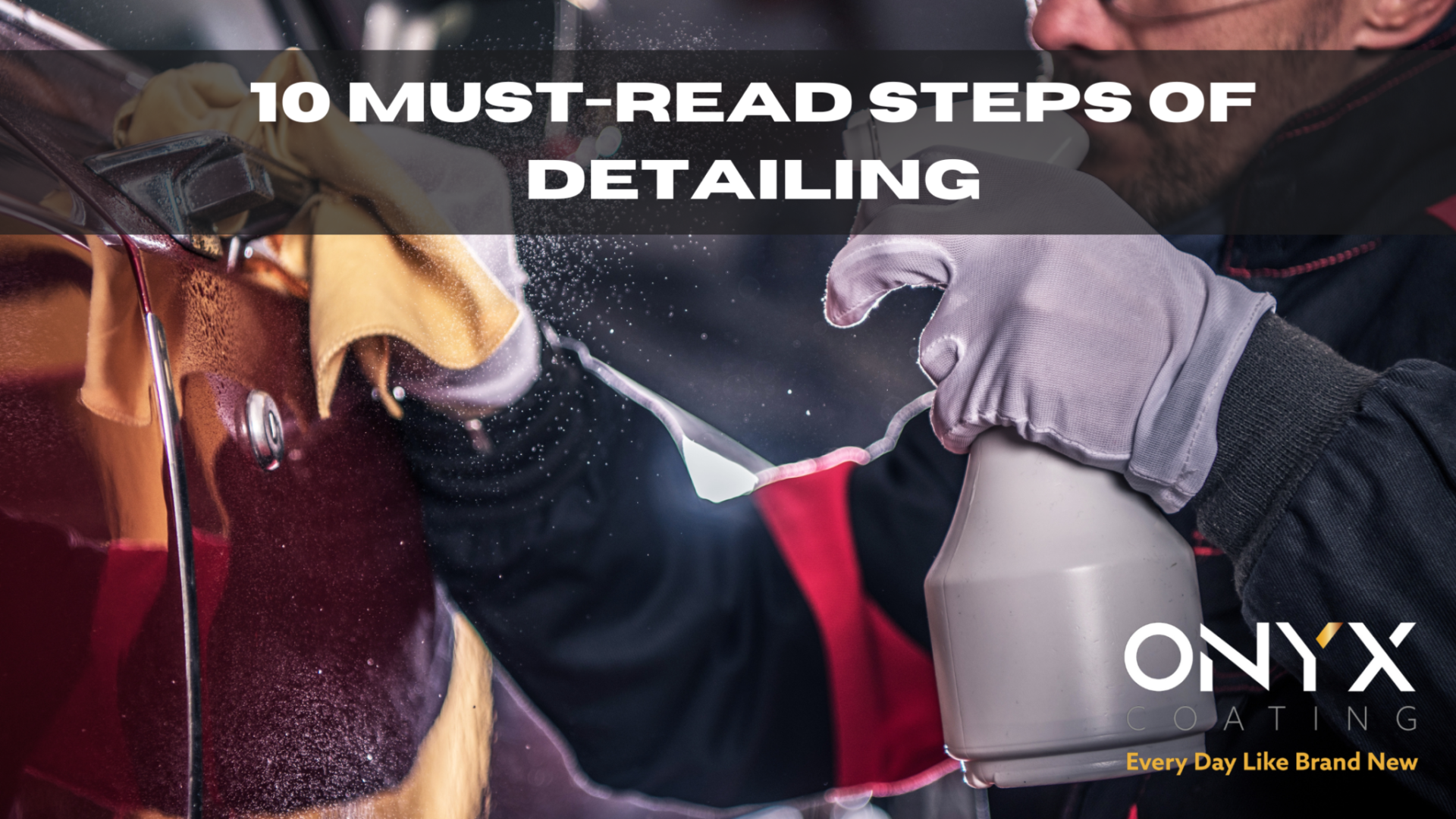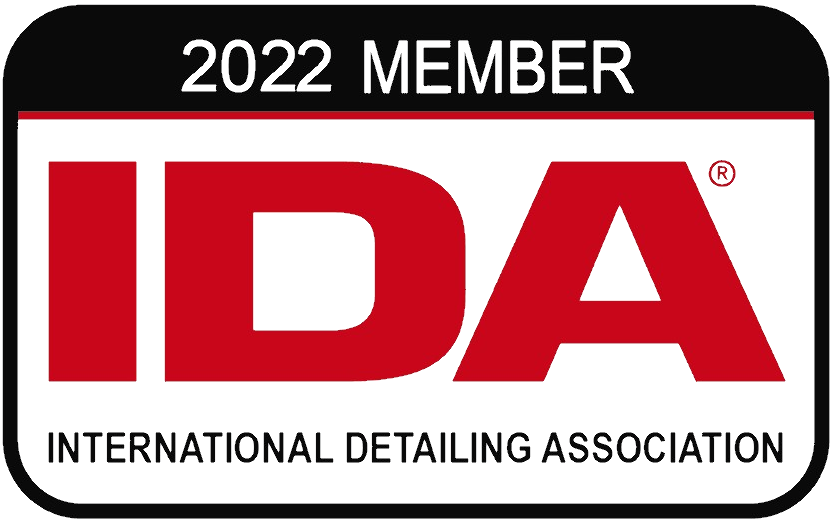
The 10 must-read steps of detailing! The world of detailing can be a maze, with many different levels, techniques, and theories, but we’re here to start you off on some basics. We can assure you that this is about as basic as it gets for proper detail.
Generally, all car detailers carry out the following processes:
This is a detailed blog article about said 10 steps and the exact products one should use as well as our professional and expert tips and tricks of the trade!
Always start with the wheels. They are the dirtiest area of the car and will require a good pre-soak with a quality wheel cleaner. To clean the hard-to-reach areas, you’ll need: brushes as well as a separate wash mitt and bucket, do not use the same for the wheels and the paintwork.
Extra tip: you can also protect the Brake Calipers
Make sure to clean the brake calipers as well, to keep them in tip-top condition we recommend applying a Caliper Ceramic Coating.
Protect the crucial components from water, rust, dirt, and chemical wear, while keeping the beautiful highlight they provide to the wheels. With a heat tolerance of up to 800°C (1450°F), the coating will keep no matter the stress put on the brakes. Along with our self-leveling technology, this coating is designed to keep the calipers looking beautiful and easy to maintain.
Daily maintenance is essential for keeping paintwork clean and free of anything that can cause irreversible damage to the paintwork. This has never been easier, to make this process quick, we have come up with a list of 3 products that work and how to use them correctly. Check out the blog article here.
Some contaminants stick to the surface like glue, even with a ceramic coating applied. This is why we recommend using a pre-cleaner to loosen up these contaminants without putting too much force, which could lead to scratches.
Spray it on the lower areas of the car, as well as anywhere else that you can see has bug remains, bird droppings etc.
Snow Foam
This step helps with assisting in breaking down any stubborn dirt, as well as removing any loose particles from the vehicle, before the physical contact wash stage. Removing as much dirt as possible before contact washing is key as it reduces the likelihood of inflicting swirl marks to the paint finish. Most swirls are caused at the wash stage.
By using the two-bucket method you can prevent cross-contamination. Alongside this, it’s incredibly important to use good-quality shampoo. Why? This further reduces the likelihood of inflicting light scratches or swirl marks.
Fill one bucket with wash solution, and the other with plain water. Start with applying the wash solution to the vehicle working from the top down in small sections at a time. Follow this up by rinsing the mitt in the water bucket before taking fresh wash solution to the car. In this way, you ensure that your wash solution is clean and that your car is always washed with clean water.
This is an important step that is not to be overlooked. When driving there is nothing more annoying than not being able to see the road ahead, which is exactly why we have come up with a list of steps to clean, protect, and get that sparkling, and smear-free finish. Check out the blog article here.
Some contaminants cannot be removed via soap. If you notice that there is tar built up, go in with a solvent tar remover. Do not try to remove this by scrubbing with a regular car wash soap.
Work your way down the vehicle starting at the top. You will be able to get every area streak-free if you take it panel by panel. During the drying process, it’s important to work quickly (to avoid water spots), while being thorough to avoid streaks.
Either you can polish it by hand or you can use a machine polisher. Even though hand polishing gives a good finish, it isn’t as good as machine polishing. Our top tip is to practice on a separate panel first. Scrap yards usually have these available. This is better than burning through your car’s paint, resulting in a full respray or even a total repaint.
For everything that is polishing, check out this guide. And here are the exact products you will need to get the job done.
Here is an outline of how you should do exactly that:
1: Plan your work. Apply the Onyx Ceramic Coating in small sections, such as one body panel at a time and if possible work in a team where one person applies the coating, and the other is ready to wipe
2: Dab the applicator cloth with the ceramic coating, as directed.
3: Working in small areas, apply the Onyx Ceramic coating
4: Once you’re done applying on one section, let sit for less than a minute to set
6: Wipe the area with an Onyx towel
7: Let the product cure for 3 hours in a covered area, without moving the car
8: Wash the car 1 week after
Vacuuming and wiping down surfaces are a given, but how does one clean the interior effectively and efficiently? Here is our must-read guide to interior detailing and maintenance!
Read more about the 3 maintenance steps to recommend to your clients to make sure their vehicle remains protected and keeps its incredible shine here.
Tune in for our next blog article that is all about the tips & tricks for installing a ceramic coating correctly!

Watch as water beads off the deck with our super hydrophobic coatings.

Protect the paintwork from UV damage and keep its vibrant colour despite the conditions.

Let the fear of a rough docking be a thing of the past with a 10H coating.

With minimal maintenance, our products are guaranteed to provide protection for years to come.

With our chemical and contaminant resistant coating, the surface is kept clean. Needing only minor occasional maintenance.

Trusted in 70+ countries, Onyx Coating is the top choice for professionals and car owners seeking premium protection.

Our ceramic coatings adhere to the surface making it resistant to corrosion and oxidation and contamination-free.

Bonds tight with the surtace to maintain a uniform cover and protect the surface evenly.
If you are interested in our products or keen to work with us, send us a message and we will get in contact with you to schedule a quick call or contact us via our email [email protected]
Once this information has been received our team will review the accounts and get into contact with you.
With the world’s first N1 nano coating product under our name, we are one of the most advanced automotive protection providers in the market.
Sign up for the latest offers & promotions




© ONYX COATING 2025. All Rights Reserved.